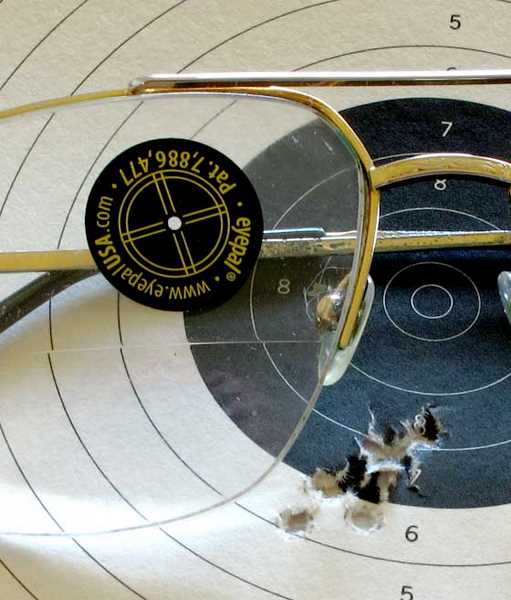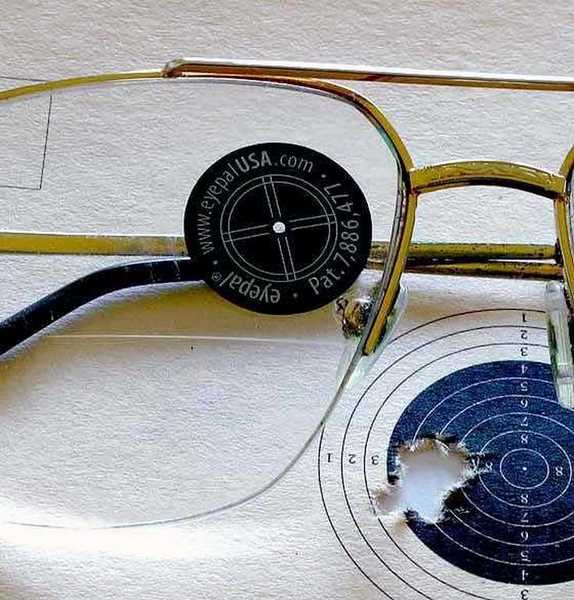The EyePal Peep Sight Master Kit
This post from Pyramyd Air airgun academy. Looks at some aspects of using the EyePal system. Original post here
I said I wasn’t going to report on the EyePal Peep Sight Master Kit by itself, but something blog reader Fred said in a comment the other day prompted this. I plan to continue to use both patches and comment on them in other reports, but today I want to focus on the kit. I don’t know if there will be a Part 2 to this report; but just in case, I marked this as Part 1.
Fred’s comment was that he needed his vision to see when he walks. So do I. Why didn’t the EyePal rifle patch bother me? The answer is what I want to talk about today — when you position the patch on your glasses.
You position the EyePal patches differently on your glasses for rifles and pistols. That’s because you look through different parts of your glasses when shooting rifles, as opposed to pistols, and that’s what I want you to see today.
Pistol shooters tend to look more toward the center of their lenses, though I suppose it varies from person to person. Also, how the glasses fit your face will determine where you look through them. But a pistol shooter is looking straight ahead more than a rifle shooter.

The pistol patch on my prescription glasses as used for an actual test. This photo will be better understood when compared to the next one.
When the pistol patch was installed, I had the same problem Fred reported — namely not being able to see well when I walked with my glasses on. The patch was right in the center of my optimum vision and obscured things I needed to see to navigate.
The rifle patch
In contrast, the rifle patch has a smaller peep hole and is color-coded with silver letters so you don’t mistake it with the pistol patch. I’ll talk more about its performance in a moment. For now, I want to concentrate on the placement of both patches and what they do to your vision.
The rifle shooter puts his head to the side of the stock. As a result, he tends to look through the glass lens closer to the edge that’s next to the nose bridge. A right-handed shooter puts the patch close to the left of his lens, and a left-hander does the opposite in the other lens. Also, the patch tends to be placed higher on the lens than when it’s used for pistol shooting, although it doesn’t look like it in these pictures.

Here you see the rifle patch as it was installed on my glasses for an actual test. Notice that it’s closer to the nose bridge and a little higher on the lens than the pistol patch.
With the rifle patch installed, I had no difficulty seeing to walk. The patch is high enough that I can look under it and get around with no problem. But each person is different, and Fred may put his patch at a different place on his glasses than I do. Or he may wear his glasses on his head differently than I do. There are many reasons the patches will go in different places, but the relationship between the rifle and pistol patch locations holds for each shooter.
There can be variables, such as the type of rifle you shoot. A 10-meter target rifle will be held more upright, and the patch will be a little lower, where a benchrest rifle gets the shooter down lower on the stock with the head leaned forward. The patch has to be higher so you can see through the peephole.
Close one eye — the big question
Most shooters close their non-sighting eye to make better sense of the sight picture when using a peep sight. Indeed, the EyePal literature shows the shooter doing this. But target shooters know this is not the way to do it! Closing the off-eye causes the peep hole to grow smaller and distort. The more you squint, the smaller and more distorted it becomes. That will ruin a fine sight picture.
I tried it both ways — the non-sighting eye held open and also with it closed. I found that the EyePal is more tolerant of closing the eye than a standard peep sight. If you continue to squint, there’s a point at which the hole will distort and close up. For the best operation, I found I could close my off-eye and find the sight picture, then open it again and hold the sight picture fine.
I’ll go into more detail when I report the guns I used the EyePal with, but I don’t want to spoil the surprises at this time. For now, let’s just say that the EyePal works for me as intended.
I said I wasn’t going to report on the EyePal Peep Sight Master Kit by itself, but something blog reader Fred said in a comment the other day prompted this. I plan to continue to use both patches and comment on them in other reports, but today I want to focus on the kit. I don’t know if there will be a Part 2 to this report; but just in case, I marked this as Part 1.
Fred’s comment was that he needed his vision to see when he walks. So do I. Why didn’t the EyePal rifle patch bother me? The answer is what I want to talk about today — when you position the patch on your glasses.
You position the EyePal patches differently on your glasses for rifles and pistols. That’s because you look through different parts of your glasses when shooting rifles, as opposed to pistols, and that’s what I want you to see today.
Pistol shooters tend to look more toward the center of their lenses, though I suppose it varies from person to person. Also, how the glasses fit your face will determine where you look through them. But a pistol shooter is looking straight ahead more than a rifle shooter.

The pistol patch on my prescription glasses as used for an actual test. This photo will be better understood when compared to the next one.
When the pistol patch was installed, I had the same problem Fred reported — namely not being able to see well when I walked with my glasses on. The patch was right in the center of my optimum vision and obscured things I needed to see to navigate.
The rifle patch
In contrast, the rifle patch has a smaller peep hole and is color-coded with silver letters so you don’t mistake it with the pistol patch. I’ll talk more about its performance in a moment. For now, I want to concentrate on the placement of both patches and what they do to your vision.
The rifle shooter puts his head to the side of the stock. As a result, he tends to look through the glass lens closer to the edge that’s next to the nose bridge. A right-handed shooter puts the patch close to the left of his lens, and a left-hander does the opposite in the other lens. Also, the patch tends to be placed higher on the lens than when it’s used for pistol shooting, although it doesn’t look like it in these pictures.

Here you see the rifle patch as it was installed on my glasses for an actual test. Notice that it’s closer to the nose bridge and a little higher on the lens than the pistol patch.
With the rifle patch installed, I had no difficulty seeing to walk. The patch is high enough that I can look under it and get around with no problem. But each person is different, and Fred may put his patch at a different place on his glasses than I do. Or he may wear his glasses on his head differently than I do. There are many reasons the patches will go in different places, but the relationship between the rifle and pistol patch locations holds for each shooter.
There can be variables, such as the type of rifle you shoot. A 10-meter target rifle will be held more upright, and the patch will be a little lower, where a benchrest rifle gets the shooter down lower on the stock with the head leaned forward. The patch has to be higher so you can see through the peephole.
Close one eye — the big question
Most shooters close their non-sighting eye to make better sense of the sight picture when using a peep sight. Indeed, the EyePal literature shows the shooter doing this. But target shooters know this is not the way to do it! Closing the off-eye causes the peep hole to grow smaller and distort. The more you squint, the smaller and more distorted it becomes. That will ruin a fine sight picture.
I tried it both ways — the non-sighting eye held open and also with it closed. I found that the EyePal is more tolerant of closing the eye than a standard peep sight. If you continue to squint, there’s a point at which the hole will distort and close up. For the best operation, I found I could close my off-eye and find the sight picture, then open it again and hold the sight picture fine.
I’ll go into more detail when I report the guns I used the EyePal with, but I don’t want to spoil the surprises at this time. For now, let’s just say that the EyePal works for me as intended.